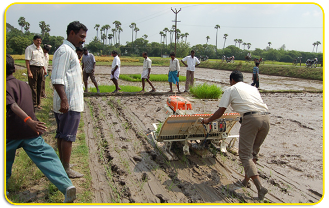|
Crop Stand Establishment
| Principles of Crop Establishment |
|
General goal:
- Establish a uniform plant stand.
- For maximum yield, plant stand must be uniform across the field.
- Transplanting gives a good stand establishment
- Direct seeding, especially wet direct seeding, may be problematic.
- If direct seed then
|
- i. Need more uniform land leveling and better water management
|
|
- ii. Seed planted too deep results in poor emergence and weak plants
|
|
|
System of Rice Intensification (SRI) |

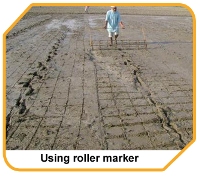 |
Seed Rate
- 7-8 kg/ha for transplanting single seedling per hill.
- 12-15 kg/ha for transplanting two seedlings per hill wherever difficulty in establishment of rice is seen.
- 15 days old seedlings are transplanted with 1-2 seedlings per hill.
- Transplant within 30 minutes of pulling out of seedlings.
A commonly practiced methods are
- Using rope with marking
- Using aluminium pipes with markings.
- Using bamboo plank with pegs as markings
- Using wooden marker
- Using roller markers
- Fill up the gaps between 7th and 10th DAT.
- There may be difficulty in crop establishment in areas with heavy downpour (North East Monsoon periods of Tamil Nadu).
Transplanting :
Transplanting consists of preparing seedlings in nursery and then planting these seedlings in the prepared main field. Transplanting ensures a uniform plant stand and gives the rice crop a head start over emerging weeds. |
Seedling Management
Optimum age of seedlings for quick establishment
Optimum age of the seedlings for transplanting is 18-22 days for short duration, 25-30 days for medium duration and 35-40 days for long duration varieties.
Pulling out the seedlings
- Pull out the seedlings at the appropriate time (4th leaf stage).
- These seedlings can produce more tillers, provided enough care is given during the establishment phase by providing thin film of water and perfect levelled of main field.
- Transplanting after 5th leaf and higher order leaf numbers will affect the performance of the crop and grain yield. They are called as ‘aged seedlings’.
Management of Aged seedlings
- Follow the spacing recommended to medium and low fertility soil
- Avoid cluster planting of aged seedlings, which are hindering the formation of new tillers.
- To encourage the tiller production, enhance the basal N application by 50% from the recommended dose.
Root dipping
- Prepare the slurry with 5 packets (1000 g)/ha of Azospirillum and 5 packets (1000g/ha) of Phosphobacteria or 10 packets of (2000g/ha) of Azophos inoculant in 40 lit. of water and dip the root portion of the seedlings for 15 - 30 minutes in bacterial suspension and then transplant.
|
Plant Density and Spacing
| In Tamil Nadu |
Varietal duration
|
Low and Medium Fertility (plant/ha)
|
Spacing
(cm) |
High Fertility
Plants / ha |
Spacing
(cm) |
| Short |
8 lakhs |
12.5 x 10 |
5.0 lakhs |
20x10 |
| Medium |
5.0 lakhs |
20x10 |
3.3 lakhs |
20x15 |
| Long |
3.3 lakhs |
20x15 |
2.5 lakhs |
20x20 |
In Kerala
| Season |
Duration |
Spacing |
No.of hills/m2 |
| First crop |
Medium
Short |
20 cm x 15 cm
15 cm x 10 cm |
33
67 |
| Second crop |
Medium
Short |
20 cm x 10 cm
15 cm x 10 cm |
50
67 |
| Third crop |
Medium
Short |
20 cm x 10 cm
15 cm x 10 cm |
50
67 |
|
Optimum age of seedlings:
Optimum age of the seedlings for transplanting is 18 days for short duration, 20-25 days for medium duration and 30 days for long duration varieties.
In Karnataka
- Spacing: 20x10cm (50 hills/ sq.meter) 2-3 seedlings per hill
- Short duration variety: 15x10cm (67 hills/ sq. meter)
- In Tungabhadra command area, for transplanting of long duration varieties such as sona masuri under delayed condition (August 15-30th) select the seedlings which are 45 days old and transplant about 3 to 4 seedlings per hill to get higher yield.
|
Planting Seedling in the main field
Number of seedlings /hill
- 2 to 4 seedlings / hill
- Saline soil : 4 to 6 seedling / hill
Depth of Planting
- Clay soil : 5 to 6 cm
- Shallow soil : 2.5 to 3.0 cm
- Shallow planting (3 cm) ensures quick establishment and more tillers.
- Deeper planting (> 5cm) leads to delayed establishment and reduced tillers.
Transplanting shock:
It occurs when the seedlings are pulled out from the nursery and
planted in the new environment. For recovery from shock, it will take minimum of 5 to 7 days
under tropics.
- Shallow planting reduces the period.
- Mild temperature after transplanting also reduces the period.
- Hot and very cold weather delays recovery.
- Best temperature: <30° C maximum and > 20° C minimum.
Gap filling
- Fill the gaps, if any within 7 - 10 days after transplanting.
|
|
| Top |
| Transplanting Methods |
|
Types :
-
Manual transplanting
-
Machine transplanting
Manual transplanting
Manual transplanting is most suited for labour-surplus areas and for small rice fields. Manual transplanting can be done in fields with less than optimal levelling and with varying water levels.
How to Transplant Rice Manually
- Pull out the seedlings at an average of 15 to 30 days after seeding (DAS) from nurseries and transport them to the main field.
- In a modified mat nursery, seedlings are ready for transplanting at 15-20 DAS and seedling mats are transported to main field.
- Transplant the seedlings soon after pulling from the nursery in puddled, leveled field (any delay will lead to slow revival and even death of some seedlings).
- Transplant 2-3 seedlings per hill at shallow depth at optimum spacing
(20 cm x 20 cm or 22.5 cm x 22.5 cm).
- Handle seedlings carefully to ensure their fast revival and rapid growth after transplanting.
Limitations :
- Transplanting is tedious and time-consuming (up to 30 person-days ha-1).
- Difficult to get enough labour at peak periods to plant on time.
- Low plant density with contract transplanting on area basis lowers yields.
- Risk, in rainfed areas, that seedlings (especially of modern varieties) may get too old before rain starts.
|
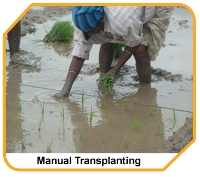

|
Machine transplanting
Machine transplanting involves planting young rice seedlings into puddled soil by machine.
How to Transplant Rice by Machine?
-
Raise seedlings in special mat nurseries or in seedling trays. Use required quantity of good seed per 100 m2 of nursery for each ha.
-
Seedlings will be ready for transplanting in 12-15 days after seeding (DAS).
Ensure that fields are well puddled and leveled.
-
Drain fields and allow mud to settle for 1-2 days after the final puddling.
-
The subsurface soil layers need to be hard enough to support the transplanting machine.
-
The soil is ready when a small “V” mark made in the puddled soil with a stick holds its shape. At this moisture level, the soil can hold the seedlings upright.
-
Soil should not be so dry that it sticks to and interferes with planting parts or wheels of the
transplanter.
-
Load the seedling mats on the machine and transplant the seedlings at the selected machine setting.
Advantages
- Machine transplanting requires considerably less time and labour than manual transplanting (1-2 ha/person/day versus 0.07 ha/person/day).
- Fast and efficient (1-2 ha/day), and ensures timely planting.
- Reduces stress, drudgery and health risks.
- Ensures uniform spacing and plant density.
- Seedlings recover fast, tiller vigorously, and mature uniformly.
Limitations
- Seedlings must be planted while still young, and so mechanical transplanting is best suited for irrigated areas only.
- Special nursery management is needed (mat nursery or seedling trays).
- Good land preparation, leveling and water management are required.
|

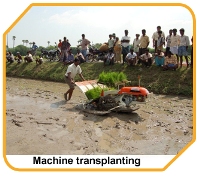 |
|
| Top |
|
Direct Wet Seeding |
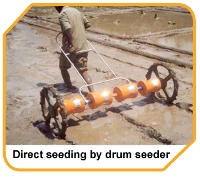 |
- Seed rate – 60 kg/ha.
- Pre germinate the seeds as for wet nursery.
- Sow the seeds by drum seeder or broadcast uniformly with thin jfilm of water.
Thinning and gap filling should be done 14-21 days after sowing.
- Dual cropping of rice-green manure is economic for nutrient budget and efficient for grain production. For this method use ‘TNAU Rice-Green manure seeder’.
- If dual cropped with green manure, incorporate the green manure when grown to 40cm height or at 30 days after sowing, whichever is earlier, using Cono-weeder.
- Green manure incorporated fields may be operated again with rotary weeder a week later in order to aerate the soil and to exploit organic acids formed if any.
|
|
| Top |
| Direct Dry Seeding |
|
In Tamil Nadu :
- Seed rate: 75 kg/ha dry seed for any recommended variety.
- Seed hardening with 1% KCl for 16 hours (seed and KCl solution 1:1) and shade dried to bring to storable moisture. This will enable the crop to withstand early moisture stress.
- On the day of sowing, treat the hardened seeds first with Pseudomonas fluroscens 10g/kg of seed and then with Azophos 2000 g or Azospirillum and Phosphobacteria @ 600 g each per ha seed, whichever is available.
- Drill sow with 20 cm inter row spacing using seed drill.
In Kerala :
- Seed rate
Broadcasting 80-100 kg/ha
Dibbling 80-90 kg/ha
[Note: The above seed rates are specified for farmers' field on the basis of minimum germination of 80%. In pokkali cultivation, for Vyttila varieties, 100 kg/ha may be sown on the beds or mounds formed in the field.
In Karnataka
:
- Seed rate – 100 kg/ha
- Possible to obtain higher yields with direct sowing of rice.
- Direct sowing of rice is preferred to transplanting rice in areas with low water availability.
- Direct seeding is a viable option in areas with shortage of water and labour.
- Large scale adoption of direct sowing is possible.
Sowing of Paddy using drum seeder
:
- Followed under late sown conditions especially in the month of July when rainfall is sufficient enough to make puddling.
- Use pre-germinated seeds for sowing
- Seed rate - 40 kg/ha
|

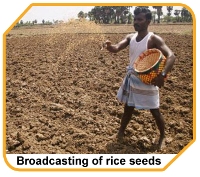
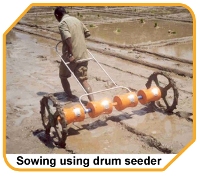
|
|
| Top |
|
Seedling Throwing Method |
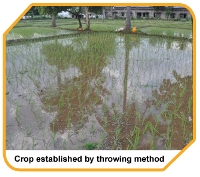 |
- 20 days old seedlings of short duration rice varieties.
- Requirement of seedlings will be approximately 20% more than the line planting or equal to random planting.
- The seedlings are thrown into the puddled leveled field by labour without using force.
- Suitable for all seasons except Thaladi or heavy rain season.
- 50% labour shaving as compared to line planting and 35% to random planting.
- Up to 7-10 days of seedling throwing care should be taken to maintain thin film of water
(similar to wet seeded rice).
- Other cultural operations are same as transplanted rice.
- Grain yield will be equal to line planted crop and 10-12% higher than random planted crop.
|
|
| Top |
|
